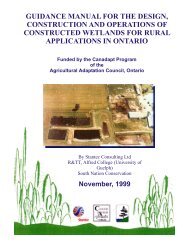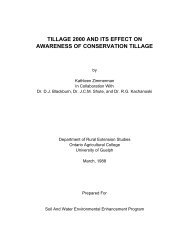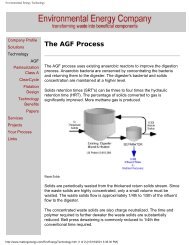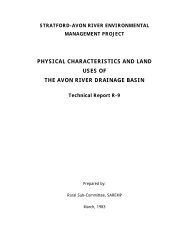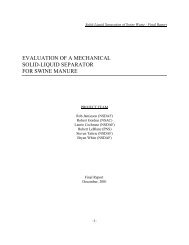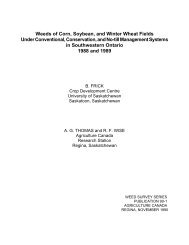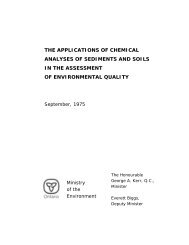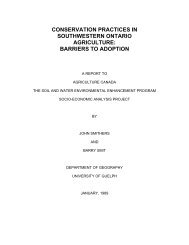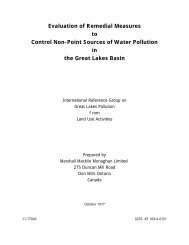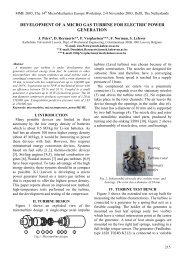Beyond Factory Farming: Corporate Hog Barns and the Threat to ...
Beyond Factory Farming: Corporate Hog Barns and the Threat to ...
Beyond Factory Farming: Corporate Hog Barns and the Threat to ...
Create successful ePaper yourself
Turn your PDF publications into a flip-book with our unique Google optimized e-Paper software.
CCPA-Saskatchewan<br />
year curve for developed regions on<strong>to</strong> <strong>the</strong> end of <strong>the</strong> 75-year curve<br />
for less developed regions. This provides a rough estimation of how<br />
a continuation of this pattern would appear in less developed regions<br />
ano<strong>the</strong>r 75 years in<strong>to</strong> <strong>the</strong> future.<br />
The global decline in farmers parallels <strong>the</strong> inverse growth of<br />
multinational agribusinesses. For example, <strong>the</strong> largest privately held<br />
company in <strong>the</strong> United States is Cargill, which accounts for nearly<br />
half of <strong>the</strong> world’s global grains. Cargill has 97,000 employees spanning<br />
59 countries as part of its nearly 51 billion-dollar annual business.<br />
O<strong>the</strong>r global food giants include <strong>the</strong> likes of Nestlé, Kraft, <strong>and</strong><br />
ConAgra, which collectively constitute a trillion-dollar industry, second<br />
only <strong>to</strong> <strong>the</strong> pharmaceutical industry as <strong>the</strong> largest in <strong>the</strong> U.S. As<br />
farmers disappear <strong>and</strong> on-farm profit margins narrow or are nonexistent,<br />
profits for global food conglomerates soar. For example,<br />
Cargill’s profits rose 131% in a mere one-year period between 2001<br />
<strong>and</strong> 2002.<br />
The global pattern of agricultural industrialization <strong>and</strong> increasingly<br />
centralized control is exemplified in North American agriculture,<br />
particularly <strong>the</strong> lives<strong>to</strong>ck industry in recent years. The swine<br />
industry is a classic example of this industrialization process. There<br />
is very little difference between <strong>the</strong> <strong>to</strong>tal U.S. inven<strong>to</strong>ry of hogs in<br />
<strong>the</strong> year 2000 (59.3 million) compared with <strong>the</strong> <strong>to</strong>tal inven<strong>to</strong>ry of<br />
hogs produced over 80 years earlier in 1915 (60.6 million) (USDA-<br />
NASS, n.d.). While overall production volume has changed little,<br />
<strong>the</strong> structure of <strong>the</strong> industry has shifted radically. As revealed in Figure<br />
3, <strong>the</strong> number of hog producers in <strong>the</strong> U.S. declined precipi<strong>to</strong>usly<br />
from <strong>the</strong> 1960s <strong>to</strong> <strong>the</strong> present. Notable in this regard is <strong>the</strong><br />
rapid rate of decline <strong>and</strong> concurrent emergence of relatively large<br />
production operations. For example, in a mere six-year period from<br />
1993 <strong>to</strong> 1999, <strong>the</strong>re was a 250% increase in <strong>the</strong> <strong>to</strong>tal U.S. hog inven<strong>to</strong>ry<br />
concentrated in operations with 5,000 or more hogs each<br />
(USDA-NASS, n.d.).<br />
The pattern is similar in Canada where <strong>the</strong> last two decades (1981<br />
<strong>to</strong> 2001) alone have witnessed <strong>the</strong> loss of over 60,000 farms, a 22%<br />
decline (Statistics Canada, n.d.). During <strong>the</strong> same period, over 40,000<br />
farms have ceased raising hogs, a whopping 72% loss of hog produc-<br />
14



